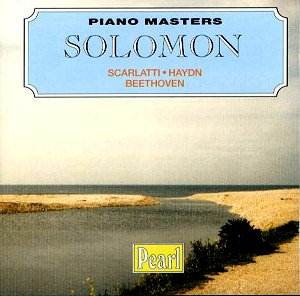Pearl’s Piano Masters series, an extensive and
entertaining collection, now reaches Solomon. The recordings are
plum label HMVs from 1946-48 and find him at his peak. We begin
with the little Scarlatti, recorded in fine, forward sound and
one of his favourites, played with patrician wit. The Haydn D
major sonata, the one that used to be called No. 37, receives
a reading of effortless brio. There’s energy in his very much
con brio reading of the first movement but great refinement
as well. The slither of a Largo e sostenuto however is graced
by glorious shades of chordal weight, by diminuendi, verticality
and an almost organ-like sonority and concentrated seriousness.
It shows precisely how a musician of his incomparable depth can
fuse the active and passive in music making, as he equally demonstrates
in the presto finale – where clarity and élan are held
in equipoise.
When we reach Beethoven we come to the F major
Sonatina, all lightness and filigree, and the C major Sonata Op.
2 No. 3. This, with the Scarlatti, was in Solomon’s repertoire
for his American tour of 1949 and was repertoire with which he
felt entirely at home. The coda of the opening Allegro con brio
is full of surging passion, the slow movement touched with simplicity,
gravity and apposite colour, with Solomon everywhere showing a
true command of sforzati. Digital clarity in the finale is accompanied
by effortless control – at least it sounds effortless – and commanding
left hand. The C minor is one of his great interpretations. In
the first movement his range of colour and powerful attacks are
potent enough, even without the extraordinary sense of power held
in check, the deeply sensitive seriousness, and the withdrawn,
stoic depth. To this extent he manages to fuse and to bind the
Maestoso first movement with the Arietta second, finding in the
opening movement a never static but necessarily considered seriousness,
even in the appassionato drive. As for the Arietta, the range
of tonal shading, command and conception still seem to me to be
one of the greatest things that even this great artist bequeathed
posterity. The tempo as such is relatively relaxed but temporal
considerations seem almost academic when confronted by playing
that holds the music in one long unbroken span and that vests
in it such profound understanding devoid of technical encumbrance.
The planned cycle of Beethoven sonatas was, as
we know, never to materialise. Solomon did re-record the Op. 2
No. 3 in the early 1950s but it never appeared, leaving the one
in this set to stand on its own. Pearl have, in effect, replicated
to a degree a Solomon recital (which would probably have begun
with a Bach-Liszt and included some Chopin). Roger Beardsley’s
transfers retain some surface noise without at all compromising
higher frequencies – and Solomon’s tonal gradations and deep beauty
are heard in all their unselfconscious glory.
Jonathan Woolf
